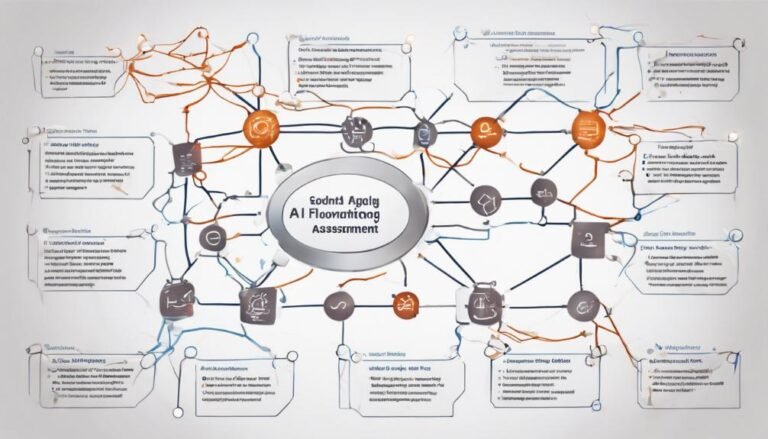Reconcile With Ease: AI Automates Financial Reconciliation
With AI transforming financial reconciliation, you can now streamline tedious tasks and enhance accuracy effortlessly. Imagine eliminating manual errors, speeding up processes, and gaining valuable insights at your fingertips. The benefits of automated reconciliation stretch beyond efficiency, offering a glimpse into the future of finance management. Embrace AI's potential to revolutionize your reconciliation practices and stay ahead in an increasingly competitive landscape.
Key Takeaways
- AI automates financial reconciliation processes efficiently.
- Reduces errors and improves accuracy through advanced algorithms.
- Streamlines transactions, enhances productivity, and saves time.
- Provides real-time updates, reliable reporting, and informed decision-making.
- Enables continuous improvement, error detection, and correction.
The Rise of AI in Reconciliation
AI has revolutionized the process of financial reconciliation, streamlining operations and increasing efficiency in various industries. With the implementation of AI in reconciliation tasks, organizations have experienced significant cost savings and improved decision-making efficiency. AI algorithms are adept at analyzing vast amounts of data quickly and accurately, enabling businesses to identify discrepancies, forecast trends, and make informed decisions promptly.
The implementation of AI in financial reconciliation has reduced manual errors and enhanced the overall accuracy of the process. By automating repetitive tasks such as matching transactions and identifying anomalies, AI has freed up valuable time for finance professionals to focus on more strategic activities. This shift towards automation hasn't only improved operational efficiency but has also minimized the risk of human error, leading to more reliable financial reporting.
Furthermore, AI-driven reconciliation systems have enabled organizations to streamline their workflows and optimize resource allocation. By leveraging AI for data analysis and decision-making support, businesses can adapt to dynamic market conditions more effectively and stay ahead of the competition. The cost savings and efficiency gains achieved through AI implementation in financial reconciliation highlight its transformative impact on modern business operations.
Benefits of Automated Reconciliation
Automated reconciliation offers you time-saving efficiency by swiftly matching large volumes of financial data with minimal manual intervention. The accuracy achieved through advanced technology reduces the risk of human errors, ensuring precise financial reporting.
Time-Saving Efficiency
By implementing automated reconciliation processes, significant time-saving efficiencies can be achieved in financial operations. Automation advantages such as time-saving technology play an essential role in streamlining the reconciliation process. Tasks that traditionally required manual intervention, like matching transactions or verifying data, can now be automated, leading to efficiency optimization and productivity enhancement.
Automated reconciliation systems have the capability to swiftly compare large volumes of data across multiple sources, flagging discrepancies and highlighting exceptions in real-time. This rapid data processing not only saves time but also reduces the risk of errors that are inherent in manual reconciliation processes.
By leveraging technology to handle routine tasks, finance teams can focus their efforts on more strategic activities that add value to the organization. The time saved through automated reconciliation translates into improved operational efficiency, faster decision-making, and better resource allocation. Companies can achieve higher productivity levels by reallocating the time saved from manual reconciliation towards analysis, forecasting, and strategic planning.
In essence, time-saving technology in reconciliation not only streamlines processes but also empowers financial teams to drive business growth and innovation.
Accuracy Through Technology
Enhancing financial accuracy is a key benefit derived from the implementation of automated reconciliation systems in modern business operations. Automated reconciliation systems improve auditing processes by greatly reducing the margin of error.
By automating the matching of transactions, these systems eliminate human error, guaranteeing that financial records are reconciled accurately and efficiently. This not only saves time but also boosts the overall accuracy of the financial data.
Moreover, automated reconciliation systems contribute to enhanced reporting capabilities. By reconciling data in real-time, these systems provide up-to-date and accurate financial information for reporting purposes. This guarantees that decision-makers have access to reliable data, empowering them to make informed choices based on the most current financial status of the business.
Improved auditing and enhanced reporting are critical components of financial accuracy, and automated reconciliation systems play a crucial role in ensuring that businesses maintain precise and reliable financial records.
Streamlining Financial Processes
To optimize operational efficiency and maximize accuracy in financial processes, the utilization of automated reconciliation systems can greatly streamline the reconciliation of transactions. Automated reconciliation not only reduces manual errors but also enhances productivity by saving time.
By automating repetitive tasks such as matching transactions, identifying discrepancies, and generating reports, businesses can achieve significant cost savings.
The streamlined process allows employees to focus on more strategic tasks that require human intervention, leading to increased productivity and efficiency within the financial department. The reduction in manual labor also minimizes the risk of errors, ensuring that financial data is reconciled accurately and in a timely manner.
Moreover, automated reconciliation systems provide real-time updates, enabling businesses to have a clear overview of their financial status at any given moment. This real-time visibility helps in making informed decisions promptly.
How AI Reduces Errors
Essentially, AI greatly reduces errors in financial reconciliation processes by leveraging advanced algorithms and machine learning capabilities. Through error reduction, AI enhances accuracy by identifying discrepancies, inconsistencies, and potential mistakes in large datasets with precision. By automating the reconciliation process, AI minimizes the likelihood of human errors such as data entry mistakes, miscalculations, and oversight.
Machine learning algorithms used in AI systems continuously learn from historical data, improving their ability to detect and correct errors over time. This iterative learning process enhances the accuracy of financial reconciliations by adapting to evolving patterns and trends in the data.
Moreover, AI can cross-verify data from multiple sources rapidly and accurately, reducing the chances of discrepancies between different financial records. By comparing vast amounts of information efficiently, AI streamlines the error identification and correction process, leading to more reliable financial reports and statements.
Essentially, AI's error-reducing capabilities elevate the accuracy of financial reconciliation tasks, providing organizations with more trustworthy and transparent financial data.
Enhancing Efficiency With AI
AI greatly enhances the accuracy of financial reconciliation by automating repetitive tasks and minimizing human error. This streamlining effect enhances efficiency by reducing the time spent on manual processes and allowing financial professionals to focus on more strategic activities.
The result is a more efficient reconciliation process that not only saves time but also improves overall accuracy and compliance.
AI Boosts Accuracy
Implementing advanced AI technology in financial reconciliation processes greatly enhances accuracy, leading to improved efficiency across the board. Through sophisticated data analysis and machine learning algorithms, AI can identify discrepancies and errors with a level of precision that surpasses traditional manual methods.
By analyzing vast amounts of financial data at high speeds, AI can quickly detect inconsistencies, anomalies, and patterns that may go unnoticed by human eyes. Machine learning algorithms continuously improve their accuracy over time by learning from historical data, making them adept at recognizing even the subtlest irregularities.
This capability not only reduces the risk of human error but also minimizes the chances of fraudulent activities slipping through the cracks undetected. Consequently, organizations can rely on AI to streamline the reconciliation process, ensuring that financial records are accurate, up-to-date, and in compliance with regulatory standards.
Streamlining Reconciliation Process
Improving the efficiency of financial reconciliation processes is essential for optimizing operational performance and ensuring accuracy in your organization's financial records. By streamlining the reconciliation process with AI, you can achieve significant cost savings and enhance analytics capabilities.
AI-powered tools can automate repetitive tasks, such as matching transactions and identifying discrepancies, reducing the time and resources required for manual reconciliation. Cost savings are realized through decreased labor costs and lower error rates, as AI can quickly process large volumes of data with precision.
Additionally, by streamlining the reconciliation process, AI enables real-time insights and improved analytics. This allows for better decision-making based on up-to-date financial information, leading to more informed strategies and increased operational efficiency.
Incorporating AI into the reconciliation process not only saves time and money but also enhances the overall quality of financial data analysis. By leveraging AI technologies, organizations can streamline their operations, reduce errors, and gain valuable insights for better financial management.
Streamlining Financial Processes
Financial processes can be optimized through careful analysis and strategic adjustments to enhance efficiency and accuracy. Implementing cost-saving strategies and efficiency enhancements in your financial workflows is essential for maximizing productivity and profitability.
By integrating data automation tools, you can streamline repetitive tasks, reduce manual errors, and guarantee data consistency across various financial operations. Workflow optimization plays a key role in eliminating bottlenecks and unnecessary steps in your processes, allowing for a more seamless flow of activities.
To achieve cost savings, consider consolidating vendor contracts, leveraging discounts for early payments, and negotiating better terms with suppliers. Efficiency enhancements can be achieved by implementing standardized procedures, utilizing technology for faster data processing, and establishing clear communication channels within your finance team.
Data automation tools like AI-powered software can significantly reduce the time spent on manual data entry and reconciliation tasks, freeing up valuable resources for more strategic financial activities.
Implementing AI Solutions
Utilizing AI solutions in your financial operations can revolutionize data processing efficiency and accuracy. When implementing AI, consider various strategies to guarantee successful integration. Begin by identifying key areas where AI can streamline processes, such as automating repetitive tasks like data entry and reconciliation.
Overcoming challenges during implementation may involve addressing data quality issues, ensuring data security, and managing change within your organization.
Training AI algorithms is vital to achieve peak performance. Provide the algorithms with high-quality data for training to enhance their accuracy and effectiveness. Continuous monitoring and updating of the AI system are essential to adapt to changing financial scenarios and maintain accuracy over time.
Implementing robust validation processes can help verify the AI's outputs and build trust in its capabilities.
Integration With Existing Systems
How can you seamlessly integrate AI solutions with your existing systems for peak performance in financial operations?
When considering the integration of AI for financial reconciliation, ensuring seamless integration and system compatibility is essential. Begin by evaluating your current systems and identifying the key areas where AI can enhance efficiency.
Look for AI solutions that offer easy integration APIs or connectors to bridge the gap between your existing systems and the new technology.
Conduct a thorough analysis of your systems' architecture to understand how AI can complement your current processes. Verify that the AI solution you choose aligns with your systems' requirements and can effectively communicate and exchange data.
Testing the integration in a controlled environment can help identify any compatibility issues early on and streamline the implementation process.
Future Trends in Reconciliation
Exploring the upcoming advancements in reconciliation technologies can provide valuable insights into the future landscape of financial operations.
The future trends in reconciliation are heavily leaning towards reconciliation automation driven by continuous technology advancements. Reconciliation automation is set to revolutionize the way financial processes are managed, offering increased efficiency, accuracy, and speed in reconciling transactions.
With the integration of artificial intelligence and machine learning algorithms, reconciliation processes will become more intelligent and adaptive, capable of handling complex data sets with ease.
Technology advancements in this field are expected to streamline the reconciliation process further, reducing manual intervention and human errors. Automated reconciliation tools won't only match transactions at a faster pace but also identify discrepancies and outliers more effectively.
As financial operations become more intricate and data volumes continue to grow, the need for advanced reconciliation solutions will be paramount. Embracing these future trends in reconciliation will certainly enhance operational efficiency and decision-making processes in the financial sector.
Conclusion
To sum up, AI is revolutionizing financial reconciliation by automating processes, reducing errors, and enhancing efficiency.
By leveraging advanced algorithms and machine learning, organizations can achieve cost savings, increase productivity, and guarantee the accuracy of their financial records with ease.
With AI streamlining financial processes, organizations can benefit from real-time updates, reliable reporting, and valuable insights for informed decision-making.
Embrace the power of AI for seamless and efficient financial reconciliation.







